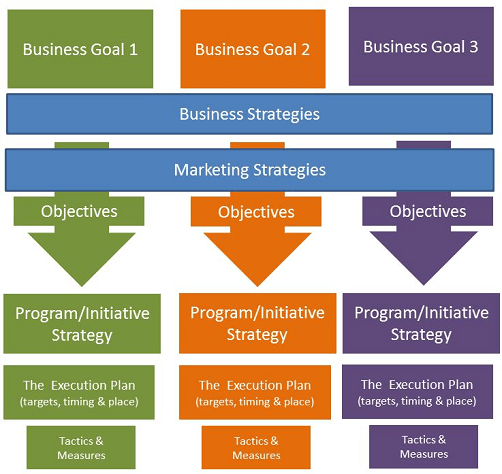There’s no shortage of how-to articles and blog posts on leveraging the power of social media. And with this endless sea of social media-touting commentary, it’s natural to think you’ve got to jump headfirst into the social sphere to keep your brand from getting left in the dust.
Although the need to engage with social media in business is undeniable, it’s easy to miss the bigger picture in all this: your business goals. Your business strategy should come first; your social media strategy should follow
Here’s why.
Getting the Sequence All Wrong
You might argue that social platforms are where your buyers are, so it makes sense to dedicate time and resources there to figure out how to reach and interact with them.
The problem with this approach is that it means viewing social media as both the beginning and end. In this scenario, social strategy is where things start and social goals are where they end. This is incredibly limiting and fails to recognize all the other, highly important parts of your business.
First, consider your business objectives. What are your biggest goals? It could be awareness, lead generation, faster customer service, or engagement with industry partners. What actions do you need your prospects and customers to take to achieve those goals? Once these things are clearly defined, you can bring social media into the conversation.
The business strategy and its goals should drive of all social efforts. For example, improved customer service might require one set of tools and resources, while changing brand perceptions and building brand awareness may require a completely different set of tools, tactics, and resources. If improving customer service is a goal, you may want to invest in a tool like Talkwalker, Mention, or Hootsuite to better monitor conversations involving your brand or industry.
Make sure you match your tool to your goal rather than the other way around. Twitter points to brands like KPMG to show how hashtags, events, and promoted Tweets can drive traffic and awareness. A recent Twitter campaign drove 90,000 website visits and over 45 million impressions from organic and promoted Tweets.
Social as a Support System
Social media is not a means to an end, but rather an arrow in your quiver. It is just one tool in the marketing mix that can be used to help you support business priorities. Jay Baer succinctly summarized it when he said, “The goal is not to be good at social media. The goal is to be good at business because of social media.”
It’s important to remember that while many marketers view social as “free,” it is not. When you invest all of your time, energy, and resources into it, something else inevitably gets dropped; it comes with opportunity costs.
Don’t neglect your other marketing in favor of social, and keep in mind that, when done in haste or outside of business goals, it can become a very public, memorable way to fail. Just recall @DiGiorno’s accidental, and taboo, “#WhyIStayed You had pizza” tweet. That one unfortunate tweet became the hallmark of the brand that year.
That said, there are several brands who’ve successfully started with the business top of mind, and used social as one approach to reach their goals. One example is Namecheap, a domain service that competes against some major players in a crowded and highly commoditized market. They’ve used social tactics to reinforce one of their top business priorities: putting the customer first.
With the “customer is king” priority, they strategically chose social as a main channel for engagement. It’s been integrated into their DNA and has become one way they communicate and show customers and prospects how they are unique. According to the company, their effective use of Twitter has helped increase domain registrants, supporting one major business goal: sales!
Another shining example is GitHub, the social network for programmers. One of the company’s goals was “GitHub everywhere.” They have a robust social strategy that includes all major social networks and a crowd-sourcing initiative to empower others to create and share their content. Another major goal of the company is storytelling. They support this with their infamous Octocat character and various video mini-series, including “Passion Projects,” which highlights women in tech.
Make It Count
Let me be clear: social is valuable, and businesses should participate, but when, where, why, and how to do so should be firmly anchored in the businesses’ priorities. Make sure your social activity maps to your buyer personas. If you’re a B2B brand, you’re likely going to be spending a lot of time on LinkedIn. If you’re a lifestyle brand, it’s probably going to be more Pinterest, Facebook, or Instagram. There’s a reason no one posts about holiday crafts on LinkedIn, and why there aren’t many whitepapers showing up on Pinterest.
As you consider changing up your approach to social media, remember to start at the highest level:
Take time to understand the high-level strategy and mission, then align your marketing strategies. Don’t let tools, tactics, and other lower-level items limit your options.










Scrivi un commento